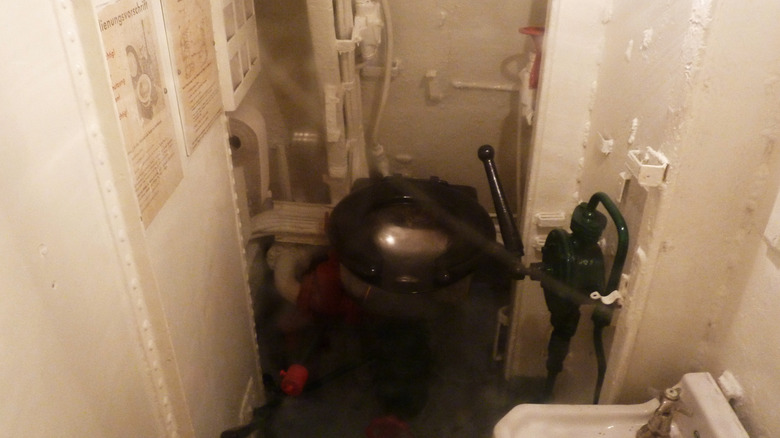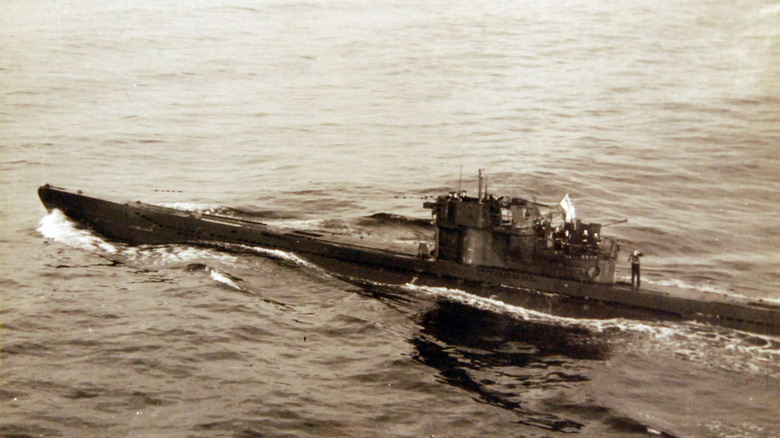The WWII German U-Boat That Was Sunk By A Malfunctioning Toilet
Accidents involving toilets typically only involve personal embarrassment, and rarely are they the cause behind the sinking of a specialized hunter-killer submarine. That's precisely what happened, however, to German Type-VIIC U-boat U-1206 on April 14, 1945. That day, the vessel apparently sank due to a trip to the lavatory by none other than the ship's commander himself, Captain Karl-Adolf Schlitt. Yes, that was his actual name. Yes, it is ridiculously easy to misread, given the circumstances.
Schlitt sat down at the lavatory, confident that German engineering would've solved the basic dilemma of waste elimination. However, Germany's wartime engineers had found a way to complicate something we all take for granted, and installed a fancy "high-tech" toilet into the submarine – more on that later. When he got up, he likely experienced a moment of shock, panic, and humiliation when he tried to flush the toilet himself and realized that he didn't actually know how to do so.
The common version of the story is that he ended up calling in an engineer to operate the toilet for him. Unfortunately, the engineer also didn't understand what the problem was, because he operated the wrong valve. This sent seawater gushing into the room and flooded the battery compartment below decks. The seawater caused the batteries to release lethal amounts of chlorine gas, forcing the sub to surface off the coast of Scotland, where it was eventually scuttled. Let's take a deep dive into one of the most bizarre U-Boat (which is short for unterseeboot) sinkings of all time.
How did a toilet sink an entire submarine?
One would imagine that operating a toilet is straightforward, but apparently that wasn't the case for certain German submarines. Here's the issue: With water pressure outside the hull greater than the pressure of flushing the toilet, how do you actually flush? If you tried hooking up a pipe leading outside, water would simply rush in through the pipe as soon as it was opened to expel the toilet's contents. Instead, German U-boats at the time used a crude but effective method of piping toilets to an internal store to be dumped when surfaced, like an underwater RV.
The problem with this solution was that it took up space and weight. U-boats were designed with a form-follows-function mindset, and thus, space was at a premium. Additionally, having to surface to dispose of waste could compromise one's position. To eliminate these perceived vulnerabilities, the Germans developed a high-pressure flushing system that allowed operators to expel waste while underwater.
While undoubtedly clever, this system relied upon a series of complex valves and cranks, meaning the toilet itself had several controls and rotating wheels to control the flow of water. Such a system required specialized knowledge to operate, with trained personnel assigned to each vessel. Ultimately, it was one of these engineers who was responsible for the sinking — evidently, flushing a toilet with several critical valves that allowed it to operate in a deep-sea environment was quite a daunting task.
The rest of the bizarre story
Whether the U-boat engineer's mistake derived from misunderstanding the issue or the toilet itself matters little. The result was the same: High-pressure seawater rushed back into Captain Schlitt's personal lavatory to such an extent that it threatened the buoyancy of the vessel and endangered the lives of its crew. With water seeping down into the battery compartment and the subsequent buildup of chlorine gas, Schlitt was forced to surface the vessel in a desperate attempt to save his crew.
Once it surfaced, British aerial patrols spotted the boat in short order and started bombing it relentlessly. Faced with imminent capture or death at Allied hands, Captain Karl-Adolf Schlitt decided to scuttle the vessel, intentionally sinking it to avoid capture by the enemy. In the midst of all this, three of U-1209's sailors perished. Schlitt himself was subsequently captured, along with his remaining crew of 45, and taken in as a prisoner of war.
It's certainly not the only famous story involving a German U-boat; there was also U-505 and its incredible tale, for example. However, it's without argument one of the most bizarre moments of the Battle of the Atlantic. Today, U-1206 is still relatively intact, having settled in its final resting place somewhere off the coast of Scotland. While its story didn't gain significant attention at the time, naval historians dredged it up in later years, and it has become a source of both humor and fascination ever since.


